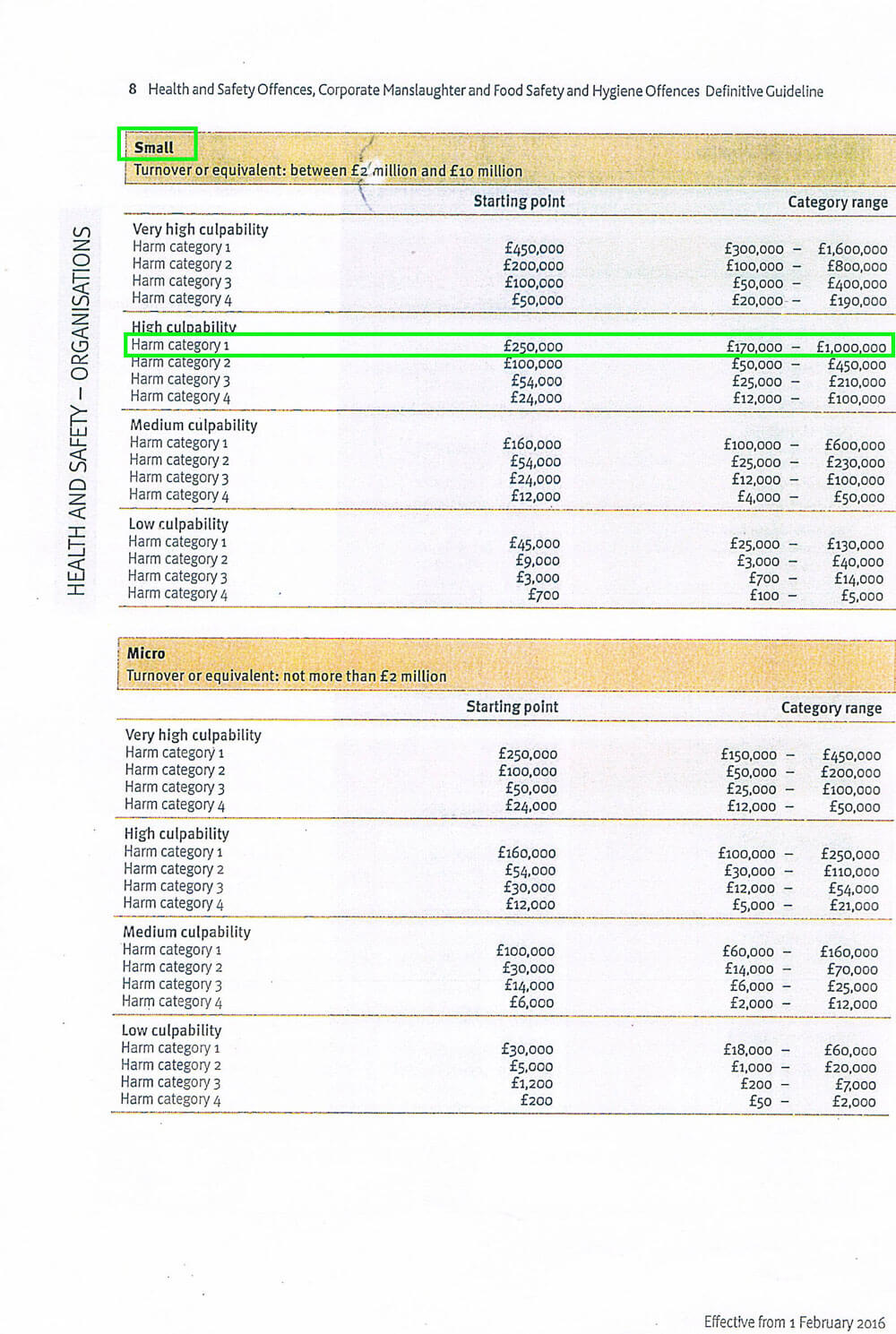By now all those concerned with health and safety in their businesses should be aware of the Sentencing Council guidelines to Health and Safety Offences, Corporate Manslaughter and Food and Safety and Hygiene Offences.
These guidelines were introduced in early 2016 and a noticeable outcome has been the draconian level of fines imposed upon businesses for various health and safety breaches since then. Many non-fatality related fines have exceeded £1 million but despite this, businesses still seem to be unaware of the impact of the guidelines.

The guidelines have also had a major effect in industry sectors where staff have developed cases of HAVS, and since 2016 it has not been uncommon for imposed fines to reach six figures for HAVS non-compliance with respect to the Control of Vibration at Work Regulations (2005). HAVS is a collective term consisting of blood vessel damage, nerve and muscular disorders of the hand and forearm, caused by frequent exposure to hand arm vibration through use of powered tools.
For those who need reminding (or for the unaware), this blog looks to explain how the guidelines work and also how the Starting point of a fine may be established. Using a realistic example, these guidelines will then be applied to a fictitious organisation where many employees regularly use powered tools and are at risk of developing HAVS. The purpose of the example is to arrive at an indication of what the starting point of an imposed fine could be for the business if it fails to put effective controls in place.
How the guidelines work
Prior to the introduction of the guidelines, it was felt that the fines handed out to offenders did little to reflect the gravity of the offence, and that not much guidance was available to the courts when passing sentence upon health and safety cases. The new guidelines now aim to ensure consistency and fairness when penalising individuals or organisations for breaches in health and safety.
There’s now a stepped (9 steps in total) approach that considers various factors before deciding the penalties to be imposed on the organisation facing prosecution. The first step considers Culpability (where the factors range from minor failings to deliberate breaches) and the Harm created by the offence (taking into account the seriousness of the risk of harm, the likelihood of harm, the number of people exposed to the risk, and whether harm was actually caused).
For the second step the courts look at the turnover of the organisation to establish a Starting point of the fine. The Starting point of the fine lies within a Category range, and whether it moves upwards or downwards from the Starting point depends upon other examples of factors that are taken into consideration, such as previous convictions, track record of health and safety, and cost cutting at the expense of health and safety.
Steps 3 to 9 look at other influencing factors such as the profitability of the organisation, the impact of the fine on its employees, and guilty pleas in finalising the fine.
Points to note are that:
- even if no harm took place, it is the risk of harm that is taken into account when deciding the fines to be imposed (you may wish to bear in mind that it only takes a disgruntled or concerned employee, or an ex-employee to alert the enforcement bodies about such risks).
- the offending organisation could be a company, a partnership, a local authority (in which case the Annual Revenue Budget is looked at as the equivalent of turnover), a health trust, or a charity.
- the judge may consider it necessary to move outside of the suggested category range to achieve a proportionate sentence, if the company is a very large organisation.
- when arriving at the fine the message that the courts want to convey is that it must be “sufficiently substantial to have a real economic impact which will bring home to both management and shareholders the need to comply with health and safety legislation.”
The starting point of a fine in an organisation where staff may be at risk from HAVS
An example of how the starting point of a fine may be predicted is shown by considering a fictitious business ABC Manufacturing Ltd. This business has an annual turnover of approximately £8 million and 12 members of staff use powered tools (angle grinders, drills, circular saws, etc.) implicated in causing HAVS. These tools are used regularly and for long periods on a daily basis.
Through what seems to be a lack of awareness, no risk assessments, methods of vibration control, staff training, or health surveillance have been provided or made available to mitigate against the risks of HAVS developing. ABC Manufacturing looks to be a ripe candidate for prosecution even though no injuries have been reported. What could the Starting point of the fine be if this business lands up in court? It is possible to predict this by applying the Sentencing Guidelines.
Step 1 determines the offence category by firstly assigning both the Culpability and the Harm.
Culpability

Figure 1 – Categorisation of the Culpability taken from the Guidelines
ABC Manufacturing Ltd look to have no controls (through lack of awareness rather than deliberately) in place for mitigation against HAVS. With reference to Figure 1, High Culpability may be an appropriate categorisation, justifiably, because the business looks to have fallen “…short of the appropriate standard, for example by failing to put in place measures that are recognised standards in the industry”. The next step is to consider Harm.
Harm

Figure 2 – Categorisation of the Harm taken from the Guidelines
Refer to Figure 2. HAVS, once contracted, is “A progressive, permanent, or irreversible condition”, so Level B may be selected in terms of Seriousness of harm risked. As the employees in ABC Manufacturing use highly vibratory tools on a regular basis, and with no form of HAV risk controls in place, it may be validly judged that there could be a High likelihood of Harm occurring. It would not therefore seem unreasonable for the courts to select the Initial harm category (paragraph 1) as Harm Category 2.
As there are 12 employees exposed to the HAVS risk, the risk of harm may be considered higher (paragraph 2), therefore the courts could decide to either move up a Harm category or substantially move up within a Category range. For the purpose of the example, Harm Category 1 shall be chosen as the Final Harm Category.
Step 2 identifies the size of the business according to the turnover, and then arrives at a Starting point of the fine and its Category range.

Figure 3 – Starting point and Category range for Small and Micro organisations taken from the Guidelines
The turnover of ABC Manufacturing Ltd is £8 million, therefore from Figure 3 ABC Manufacturing may be classified as a Small organisation (i.e. a turnover of between £2 million and £10 million).
With High Culpability, Harm Category 1, and a turnover of £8 million, this would give a Starting point of the fine as £250k. The final amount (which could be anywhere between £170k and £1million in the Category range) as mentioned before depends upon the outcome of carrying out steps 3 to 9.
Note that if actual harm DID take place then the courts would be entitled to move the Starting point of the fine upwards within the Category range (see Figure 2, bottom paragraph).
As previously mentioned, the courts are also entitled move outside of the suggested Category range for very large organisations.
For reference, another table for different sized organisations is shown in Figure 4. This shows the Starting points of the fines and the Category ranges for businesses with larger turnovers than the example used for ABC Manufacturing.

Figure 4 – Starting point and Category range for Medium and Large organisations taken from the Guidelines
HAVS prosecutions since 2016
Below are some examples (with links to webpages) of six figure fines imposed upon organisations that were prosecuted for the occurrences of HAVS (i.e. actual harm caused) since the introduction of the Sentencing Guidelines in early 2016.
- Local Authority (poor control of risks), fined £250k, November 2016.
(see https://www.shponline.co.uk/noise-and-vibration/48479-2/) - Aircraft component repair and maintenance business (failure to carry out a suitable risk assessment), fined £400k, September 2018.
(see http://press.hse.gov.uk/2018/company-fined-after-workers-exposed-to-hand-arm-vibration-syndrome/) - Construction company (failed to put effective risk controls in place and provide a suitable health surveillance programme), fined £500k in June 2018.
(see https://press.hse.gov.uk/2018/06/18/balfour-beatty-utility-solutions-ltd-fined-half-a-million-pounds-after-exposing-workers-to-debilitating-condition/) - Construction company (inadequate risk assessment and risks poorly managed), fined £280k in April 2016.
(see https://www.shponline.co.uk/in-court/two-firms-fined-for-safety-breaches/)
The message is quite clear. Organisations have only to put workers’ health and safety at risk for courts to act mercilessly by imposing heavy fines, and these fines now also take into account the size of the business. It’s worth noting that if there are breaches and the HSE get inevitably involved, IN ADDITION to the fines, the organisation has to take into account:
- its legal fees
- the HSE’s legal fees
- the HSE’s fees for intervention (currently standing at £154 per hour)
So to do nothing is by far the biggest risk you are taking!
What can you do about it?
If you have a risk assessment (carried out by someone competent) in place, it should have recommended controls to implement for offering protection against HAVS. Do ensure that the recommendations have been implemented.
However, if you are unsure on how to carry out a risk assessment, a free guide to conducting a hand arm vibration risk assessment is available for download.
It explains, amongst other things, when you should carry one out, and what constitutes a competent risk assessment. . Click here to receive it.

